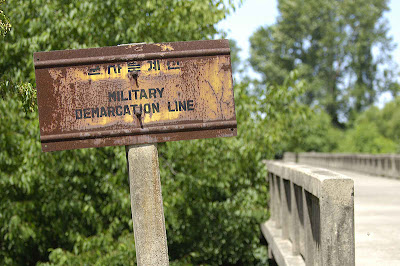Demilitarised Zone, North Korea
Inside the Korean Demilitarized Zone. Military Demarcation Line sign on the south side of the Bridge of No Return.
(Source: http://172.31.254.243/upload.wikimedia.orgg/wikipedia/commons/thumb/a/af/MilitaryDemarcationLine.jpg/800px-MilitaryDemarcationLine.jpg)
A South Korean sentry near the demilitarized zone.
(Source: http://172.31.254.241/upload.wikimedia.orgg/wikipedia/commons/thumb/0/01/Korea_DMZ_sentry.jpg/800px-Korea_DMZ_sentry.jpg)
Question 1:
What is this place?
-It is a border that stretches from the west to the east coast of the Korean peninsula. It is something of a misnomer, considering the huge number of military personnel ( over 2 million troops ) and materiel in position.
Question 2:
Where is this place?
-It is where North and South Korea is divided. It is also known as “The 38th Parallel”.
Question 3:
Why do tourists visit this place?
-It is one of the relics of the Cold War. It also has a large amount of biodiversity, as the DMZ has been restricted to the general public for over 50 years, causing it to be a wildlife preserve. It’s natural beauty and history attracts tourists.
Question 4:
What is the source of information?
-http://www.japanvisitor.com/index.php?cID=381&pID=826#ixzz0crrM0jzs
-http://asiaenglish.visitkorea.or.kr/ena/SI/SI_EN_3_4_1.jsp
Done by: Kalayarat Vanich 4M, Clarissa Yeo 4R
http://en.wikipedia.org/wiki/Korean_Demilitarized_Zone
http://www.koreatimes.co.kr/www/news/opinon/2007/10/137_12129.html
1) What is this place?
The Korean Demilitarized Zone (Korean: 한반도 비무장지대) is a strip of land running across the Korean Peninsula that serves as a buffer zone between North and South Korea.. It is 155 miles (248 km) long and approximately 2.5 miles (4 km) wide, and is the most heavily militarized border in the world.
2) Where is this place?
The DMZ cuts the Korean Peninsula roughly in half, crossing the 38th parallel on an angle, with the west end of the DMZ lying south of the parallel and the east end lying north of it.
3) Why do tourists visit this place?
At demilitarised zone, people visit to places like Panmunjom , 3rd infiltration tower, nature reserve, and village in side DMZ. Tourists visit this place as they can learn more about the relationship between North and South Korea North Korea
4) What are the sources of information for this place?
http://www.tourdmz.com/english/05koreawar/p1.php
http://www.koreadmztour.com/english/dmz/dmz_3.htm
http://www.koreadmztour.com/english/jsa/jsa_18.htm
http://en.wikipedia.org/wiki/Korean_Demilitarized_Zone
http://www.koreadmztour.com/english/dmz/dmz_8.htm
5) How was demilitarized zone in Korea
Subsequently, four occasions of unwilled conferences resulted in consequences which were far from the country’s desire of a unified nation and the opposed government of trusteeship was settled. From this point on, the partition of the Korean peninsula was firmly settled as two different governments were established on each side; the Republic of Korea Republic of Korea
On June 25th, 1950 , with the intent of communization, North Korea Soviet Union . After the outbreak of the war, the North occupied Seoul Nakdong River
By the success of the U.N. Force’s Incheon Landing Operation, the South regained Seoul Wonsan United States
The UN proposed a change of location for the meeting on the ground that Gae-sung is located north of the 38th Parallel. The Soviet Union accepted the proposal and in October 1951, the Panmunjom was determined as the new conference location.
As a result, the Korean peninsula was divided into two separate nations without the consent of its own people, and the one and only Demilitarized Zone in the world was born.
6) What are the main tourist attractions in DMZ?
The DMZ is the only place in the world where confronting ideologies still face each other. The DMZ ranges from the Han River Estuary, at the western end of Korea
Unlike any other place, Panmunjom shows the tension between two nations and also makes one realize the importance of the liberty and the peace. In the JSA, the tour is conducted under the solemn and watchful eyes of the UNCSB-JSA soldiers.
3rd Infiltration Tunnel
Only 44 kilometres or, less than an hour's drive, from Seoul
Capable of moving a full division per hour, plus their weapons, it is evidently designed for a surprise attack onSeoul
Capable of moving a full division per hour, plus their weapons, it is evidently designed for a surprise attack on
Nature reserve
The only permanent residents of the DMZ are the various plants and animals that are sheltered from human contact. The DMZ is also the only place where peace and tension coexist and people who long for peace continue to visit without fail.
In the past half century, the Korean DMZ has been a deadly place for humans, making habitation impossible. Only around the village of PanmunjeomKorea
This natural isolation along the 155 miles (249 km) length of the DMZ has created an involuntary park which is now recognised as one of the most well-preserved areas of temperate habitat in the world.
Several endangered animal and plant species now exist among the heavily fortified fences, landmines and listening posts. These include the extremely rare Red-crowned Crane (a staple of Asian art), and the White-naped crane as well as, potentially, the extremely rare Korean Tiger, Amur leopard and Asiatic black bear. Ecologists have identified some 2,900 plant species, 70 types of mammals and 320 kinds of birds within the narrow buffer zone. Additional surveys are now being conducted throughout the region.
The DMZ, which is up to 2.5 miles (4.0 km) wide, owes its varied biodiversity to its geography which crosses mountains, prairies, swamps, lakes and tidal marshes. Environmentalists hope that by the time reunification occurs, the former DMZ will be conserved as a wildlife refuge, with a well-developed set of objective and management plans vetted and in place. In 2005 CNN founder and media mogul, Ted Turner, on a visit to North Korea, said that he would financially support any plans to turn the DMZ into a peace park and a UN-protected World Heritage Site.
done by, Lee Sae Yun 4D, Lim Yi Xian 4D








Dark tourism!!! Because it is one of the relics of the Cold War.
Woots.
I guess so...But it's also based on nature-based tourism. Do you know that there are endangered animals living in that place? Besides,it's a UN-protected World Heritage Site. ;)
-Lee Sae Yun, Lim Yi Xian (4D)